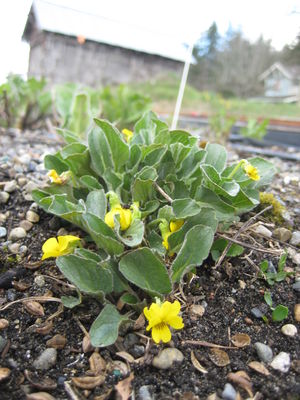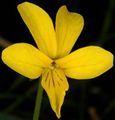Difference between revisions of "Viola nuttallii var. praemorsa"
| Line 1: | Line 1: | ||
| − | |||
* Scientific Name: ''Viola nuttallii'' var. ''praemosa'' | * Scientific Name: ''Viola nuttallii'' var. ''praemosa'' | ||
* Family: Violaceae | * Family: Violaceae | ||
| Line 5: | Line 4: | ||
* Synonyms/Misapplications: V. ''praemorsa'', V, ''praemosa'' vars. ''flavovirens, linguifolia'' | * Synonyms/Misapplications: V. ''praemorsa'', V, ''praemosa'' vars. ''flavovirens, linguifolia'' | ||
* Codon: VIONUT | * Codon: VIONUT | ||
| + | ---- | ||
| + | [[File:VIPR AnitaGoodrich veg good.jpg|thumb|Photo Anita Goodrich, also featured on Main Page]] | ||
| − | ==Taxonomy== | + | ===Taxonomy=== |
{{Taxobox | {{Taxobox | ||
| − | | name = | + | | name = |
| regnum = [[Plant]]ae | | regnum = [[Plant]]ae | ||
| subregnum = Viridiplantae | | subregnum = Viridiplantae | ||
| Line 26: | Line 27: | ||
<ref>Integrated Taxonomic Information System. Retrieved from https://www.itis.gov/servlet/SingleRpt/SingleRpt?search_topic=TSN&search_value=847695#null</ref> | <ref>Integrated Taxonomic Information System. Retrieved from https://www.itis.gov/servlet/SingleRpt/SingleRpt?search_topic=TSN&search_value=847695#null</ref> | ||
| − | ==Description== | + | ===Description=== |
General: Perennial from short, erect rhizomes, the stems up to 15 cm. long. | General: Perennial from short, erect rhizomes, the stems up to 15 cm. long. | ||
Leaves: Leaf blades conspicuously hairy, thick and fleshy, entire, ovate-lanceolate, 5-10 cm. long; petiole 5-15 cm. long; stipules attached to the petiole, the free portion few-toothed. | Leaves: Leaf blades conspicuously hairy, thick and fleshy, entire, ovate-lanceolate, 5-10 cm. long; petiole 5-15 cm. long; stipules attached to the petiole, the free portion few-toothed. | ||
| Line 35: | Line 36: | ||
Retrieved from https://biology.burke.washington.edu/herbarium/imagecollection/taxon.php?Taxon=Viola%20nuttallii%20var.%20praemorsa</ref> | Retrieved from https://biology.burke.washington.edu/herbarium/imagecollection/taxon.php?Taxon=Viola%20nuttallii%20var.%20praemorsa</ref> | ||
| − | ==Bloom Period== | + | ===Bloom Period=== |
April-July | April-July | ||
| − | ==Distribution== | + | ===Distribution=== |
Both sides of the Cascades, into Northern California, east to Montana, Wyoming and Northern Utah.<ref>Hitchcock, C. L., Cronquist, A., Giblin, D., & Legler, | Both sides of the Cascades, into Northern California, east to Montana, Wyoming and Northern Utah.<ref>Hitchcock, C. L., Cronquist, A., Giblin, D., & Legler, | ||
B. et al. (2018). ''Flora of the Pacific Northwest: an illustrated manual''. | B. et al. (2018). ''Flora of the Pacific Northwest: an illustrated manual''. | ||
Seattle: University of Washington Press.</ref> | Seattle: University of Washington Press.</ref> | ||
| − | ==Habitat== | + | ===Habitat=== |
Grasslands, shrub-steppe, open forest. | Grasslands, shrub-steppe, open forest. | ||
Moisture Regime-Moist | Moisture Regime-Moist | ||
Shade Tolerance-Intolerant | Shade Tolerance-Intolerant | ||
| − | ==Photo Gallery<ref name=":0" />== | + | ===Photo Gallery<ref name=":0" />=== |
<gallery> | <gallery> | ||
File: Viola nuttallii facing 1.jpg | G.D. Carr 2008 | File: Viola nuttallii facing 1.jpg | G.D. Carr 2008 | ||
| Line 54: | Line 55: | ||
</gallery> | </gallery> | ||
| − | ==References== | + | ===References=== |
<references /> | <references /> | ||
Revision as of 23:21, 20 March 2021
- Scientific Name: Viola nuttallii var. praemosa
- Family: Violaceae
- Common Names: canary violet, upland yellow violet, yellow montane violet
- Synonyms/Misapplications: V. praemorsa, V, praemosa vars. flavovirens, linguifolia
- Codon: VIONUT
Contents
Taxonomy
| Scientific classification | |
|---|---|
| Kingdom: | Plantae |
| Subkingdom: | Viridiplantae |
| Phylum: | Tracheophyta |
| Subphylum: | Spermatophytina |
| Class: | Magnoliopsida |
| Subclass: | Rosanae |
| Order: | Malpighiales |
| Family: | Violaceae |
| Genus: | Viola L. |
| Species: | Viola nuttallii Pursh |
| Subspecies: | Viola nuttalli var. praemorsa (Douglas ex Lindl.) S. Watson (not accepted) |
| Synonyms | |
| |
Description
General: Perennial from short, erect rhizomes, the stems up to 15 cm. long. Leaves: Leaf blades conspicuously hairy, thick and fleshy, entire, ovate-lanceolate, 5-10 cm. long; petiole 5-15 cm. long; stipules attached to the petiole, the free portion few-toothed.
Flowers: Flowers with peduncles shorter than the leaves; flowers 8-15 mm. long, yellow, the upper petals brownish-backed, the lower 3 penciled with brownish-purple, the lateral pair bearded; style head bearded, rounded.
Fruit: Fruit a hairy, 3-valved capsule, ovary superior, placentation parietal.[2]
Bloom Period
April-July
Distribution
Both sides of the Cascades, into Northern California, east to Montana, Wyoming and Northern Utah.[3]
Habitat
Grasslands, shrub-steppe, open forest. Moisture Regime-Moist Shade Tolerance-Intolerant
Photo Gallery[2]
References
- ↑ Integrated Taxonomic Information System. Retrieved from https://www.itis.gov/servlet/SingleRpt/SingleRpt?search_topic=TSN&search_value=847695#null
- ↑ 2.0 2.1 WTU Herbarium, Burke Museum, & University of Washington. Retrieved from https://biology.burke.washington.edu/herbarium/imagecollection/taxon.php?Taxon=Viola%20nuttallii%20var.%20praemorsa
- ↑ Hitchcock, C. L., Cronquist, A., Giblin, D., & Legler, B. et al. (2018). Flora of the Pacific Northwest: an illustrated manual. Seattle: University of Washington Press.





